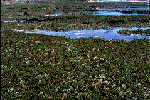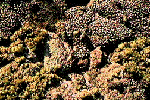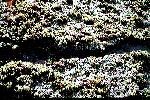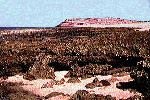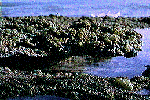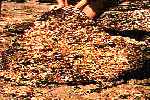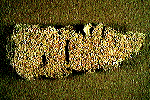Beachrock Microhabitats
Be sure to write about what you are learning in the lab section of your notebook. You will be expected to answer questions about the lab activity during the lab self test and lab quiz. It helps to have your text and coloring books open beside you for support.
| Refer to the Assigned Readings Below: | |
| Marine Biology Textbook | Chapter 11, pages 236 to 244 |
| Marine Biology Coloring Book | Plate 3 to 6 |
|
Upper Beachrock
|
|
|
|
|
|
Observations: The beachrock lying close to the sandy beach is located at tidal heights between +1 and +2 feet. This beachrock is inhabited by a different association of organisms from that located lower in the intertidal. The upper beachrock is at greater risk of drying completely during spring tides and experiences greater temperature changes than the lower beachrock. |
|
Lower Beachrock
|
|
|
|
|
|
Observations: The beachrock lying close to the low tide line is located at tidal heights between -1 and +1 feet. This beachrock is inhabited by a different association of organisms from that located higher in the intertidal. The lower intertidal beachrock is exposed to the air for short periods of time during spring tides only. |
|
Beachrock Surfaces
|
||
|
|
||
|
Observations: The surfaces of the beachrock are inhabited by a variety of seaweeds and invertebrate animals. In general the amount of living material associated with these surfaces increases seaward and is greatest below the 0 tidal level. The numbers of species (diversity) also increases in a seaward direction. |
||
|
Study Questions:
|
||
|
Study Questions:
Click to observe invertebrates
|
||
|
Study Questions:
|
|
Beachrock Crevices
|
|
|
|
|
|
Observations: Crevices in the beachrock provide added protection from environmental hazards including temperature extremes, drying, and predation. The shade inside beachrock cracks creates a microhabitat that is cool and moist. The tight spaces make it difficult for predaceous animals to manipulate or remove prey. |
|
|
Study Questions:
|
|
Beachrock Overhangs
|
||
|
|
||
|
Observations: Beachrock overhangs are produced by erosive activities that undercut the rock platform leaving suspended visors of rock. The lack of sunlight under the visors makes it difficult for seaweeds to survive. This makes it easier for sessile animals to establish themselves by reducing competition for a space to anchor to the rock and grow. |
||
|
Study Questions:
|
|
Beachrock Slabs
|
|
|
|
|
|
Observations: Beachrock slabs are produced by erosive activities that completely undercut the visors of rock so that they colapse onto the rock platform. The slabs can be moved by large waves but since they are flat they resist being overturned. The lack of sunlight under the slabs makes it impossible for seaweeds to survive. This makes it easier for sessile animals to establish themselves by reducing competition for a space to anchor to the rock and grow. |
|
|
Study Questions:
|
|
Inside Beachrock
|
|
|
|
|
|
Observations: The beachrock is soft and held together by calcium carbonate cement. As such it is subject to chemical and biological weathering. Rain falling on beachrock at low tide will dissolve the calcium carbonate enough to form tiny pits in its surface. These pits can be occupied by the larvae of boring species which can, to varying degrees, enlarge the cavities by mechanical abrasion and by the secretion of minute amounts of acid that will further dissolve the carbonate cement. Many boring species occupy the same cavities throughout their lives enlarging them until they die. Borings left after the deaths of the borers may then be used as homes by non-boring species. The beachrock is riddled with bored cavities and these small spaces are another microhabitat. Inside the cavities conditions are cramped, dark, cool and wet. |
|
|
Study Questions:
|
| Lab Activity 9.1 Beachrock Seashore |




